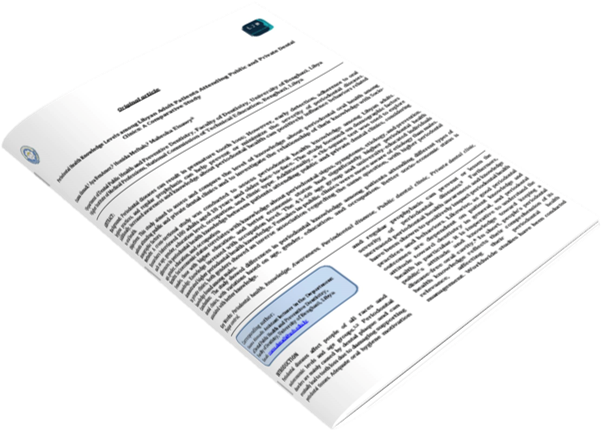Periodontal Health Knowledge Levels among Libyan Adult Patients Attending Public and Private Dental Clinics: A Comparative Study
DOI:
https://doi.org/10.37376/ljd.v8i1.5876Keywords:
Periodontal health, knowledge, Awareness, Periodontal disease, Public dental clinic, Private dental clinic, Plaque controlAbstract
Background: Periodontal diseases can result in premature tooth loss; However, early detection, adherence to oral hygiene practices, and regular prophylaxis can help prevent or minimize the severity of periodontal diseases. Additionally, increased awareness and knowledge about periodontal health can positively influence behaviors related to oral health.
Objectives: This study aimed to assess and compare the level of knowledge about periodontal oral health among patients attending public and private dental clinics and to investigate the relationship of their knowledge with Socio-demographic factors.
Methods: A cross-sectional study was conducted to assess periodontal health knowledge among Libyan adults. Researchers interviewed 180 adults aged 18 years and older face-to-face. The study focused on demographic factors such as age, gender, education level, occupation, and clinic type. Additionally, a chi-square test was used to explore differences in periodontal health knowledge between patients attending public and private dental clinics, considering age, gender, education, and occupation
Results: Socioeconomic status correlates with knowledge about periodontal signs, symptoms, etiology, and prevention. Females, those with higher education, and better economic status had significantly higher periodontal health knowledge. Knowledge increased with occupation level. The 41-60 age group and university-educated individuals demonstrated higher periodontal health knowledge. Females in public clinics were more aware of etiology than males. In private clinics, both genders showed an inverse association regarding the same question, with higher periodontal knowledge found among males.
Conclusion: The study showed differences in periodontal knowledge among patients attending different types of dental clinics, with variations based on age, gender, education, and occupation. Better socio-economic status is associated with better knowledge.
Downloads
References
Albandar JM, Rams TE. Global epidemiology of periodontal diseases: an overview. Periodontol 2000 .2002;29(1):7-10.
Albandar JM, Tinoco E. Global epidemiology of periodontal diseases in children and young persons. Periodontol 2000.2002;29(1):153-76.
Chapple IL, Van der Weijden F, Doerfer C, Herrera D, Shapira L, Polak D, et al. Primary prevention of periodontitis: managing gingivitis. J Clin Periodontol. 2015;42:S71-S6.
Needleman I, Nibali L, Di Iorio AJJoCP. Professional mechanical plaque removal for prevention of periodontal diseases in adults–systematic review update. J Clin Periodontol. 2015;42:S12-S35.
Phipps KR, Stevens VJ. Relative contribution of caries and periodontal disease in adult tooth loss for an HMO dental population. J Public Health Dent. 1995;55(4):250-2.
El‐Qaderi S, Quteish Ta'ani D. Assessment of periodontal knowledge and periodontal status of an adult population in Jordan. Int J Dent Hyg. 2004;2(3):132-6.
Gholami M, Pakdaman A, Jafari A, Virtanen JJ. Knowledge of and attitudes towards periodontal health among adults in Tehran. EMHJ. 2014; 20 (3): 196-202.
Mariotti AJAop. Dental plaque‐induced gingival diseases. Ann Periodontol. 1999;4(1):7-17.
Peeran SW, Altaher OB, Peeran SA, Alsaid FM, Mugrabi MH, Ahmed AM, Grain A. Oral health in Libya: addressing the future challenges. Libyan J Med. 2014;9(1).
Tarhuni H, Benghasheer HF, Naser Y, Arheiam AJIJoPD. Molar incisor hypomineralisation: A survey of awareness and management strategies among Libyan dentists in Benghazi. Dent J Pediatr Dent. 2024.
Arheiam A, Alhashani A, Kwidir T, Bosif Y, Ballo L, Tantawi ME. Untreated dental caries among Libyan children during and after the war and in internally displaced person camps. Community Dent oral Epidemiol. 2023;51(4):636-43.
Arheiam A, Aloshiby A, Gaber A, Fakron S. Dental fluorosis and its associated factors amongst Libyan schoolchildren. Int Dent J. 2022;72(6):853-8.
Arheiam A, Abbas S, Ballo L, Borowis E, Rashwan S, El Tantawi M. Prevalence, distribution, characteristics and associated factors of molar-incisor hypo-mineralisation among Libyan schoolchildren: a cross-sectional survey. Eur Arch Paediatr Dent. 2021;22:595-601.
Varela‐Centelles P, Diz‐Iglesias P, Estany‐Gestal A, Seoane‐Romero JM, Bugarín‐González R, Seoane J. Periodontitis awareness amongst the general public: a critical systematic review to identify gaps of knowledge. J Periodontol. 2016;87(4):403-15.
Chandola T, Jenkinson C. The new UK National Statistics Socio-Economic Classification (NS-SEC); investigating social class differences in self-reported health status. J Public Health. 2000;22(2):182-90.
Hamilton ME, Coulby WM. Oral health knowledge and habits of senior elementary school students. J Public Health Dent. 1991;51(4):212-9.
Persson GR, Persson RE, Hollender LG, Kiyak HA. The impact of ethnicity, gender, and marital status on periodontal and systemic health of older subjects in the Trials to Enhance Elders' Teeth and Oral Health (TEETH). J Periodontol. 2004;75(6):817-23.
Torrungruang K, Tamsailom S, Rojanasomsith K, Sutdhibhisal S, Nisapakultorn K, Vanichjakvong O, et al. Risk indicators of periodontal disease in older Thai adults. J Periodontol. 2005;76(4):558-65.
Jain M, Mathur A, Sawla L, Choudhary G, Kabra K, Duraiswamy P, et al. Oral health status of mentally disabled subjects in India. J oral Sci. 2009;51(3):333-40.
Roberts‐Thompson KF, Spencer AJ. Public knowledge of the prevention of dental decay and gum diseases. Aust Dent J. 1999;44(4):253-8.
Doifode V, Ambadekar N, Lanewar A. Assessment of oral health status and its association with some epidemiological factors in population of Nagpur, India. Indian J Med Sci. 2000;54(7):261-9.
Mårtensson C, Söderfeldt B, Andersson P, Halling A, Renvert S. Factors behind change in knowledge after a mass media campaign targeting periodontitis. Int J Dent Hyg. 2006;4(1):8-14.
Tada A, Hanada NJPh. Sexual differences in oral health behaviour and factors associated with oral health behaviour in Japanese young adults. Public Health. 2004;118(2):104-9.
Galdas PM, Cheater F, Marshall P. Men and health help‐seeking behaviour: literature review. J Adv Nurs. 2005;49(6):616-23.
Khanal K, Shrestha D, Ghimire N, Younjan R, Sanjel S. Assessment of knowledge regarding oral hygiene among parents of pre-school children attending pediatric out patient department in Dhulikhel hospital. Kathmandu Univ Med J. 2015;13(1):38-43.

Downloads
Published
How to Cite
Issue
Section
License
Copyright (c) 2024 Libyan Journal of Dentistry

This work is licensed under a Creative Commons Attribution-NonCommercial-NoDerivatives 4.0 International License.







